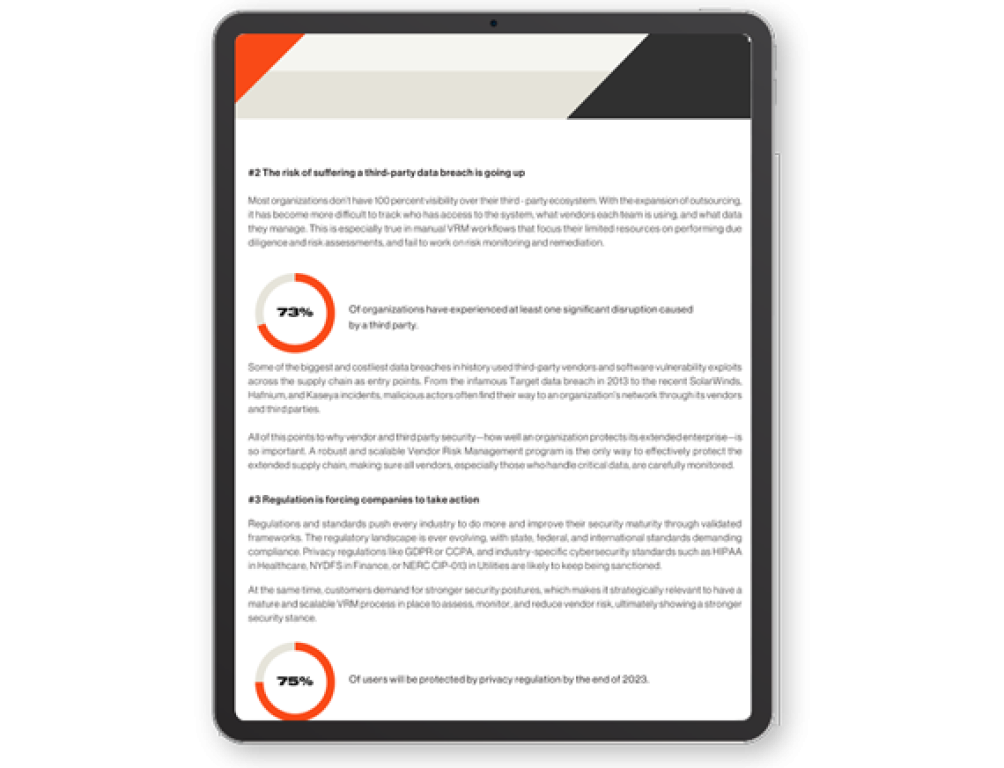Streamline onboarding, automate assessments, and stay ahead of third-party threats—without burning out your team.
3 Steps to an Automated Vendor Risk Assessment Program
Tags:


Third-party vendors are critical to increasing efficiency, delivering better customer experiences, and reducing costs. But vendors also bring cybersecurity risk – 73% of organizations have experienced at least one significant disruption caused by a third-party.
To reduce third-party risk, it’s important that you assess vendors at each step of the vendor relationship. But vendor risk management (VRM) often involves manual, inefficient, time-consuming processes that are spread across too many teams and tools and are hard to scale across the evolving third-party risk landscape.
Because of this, many organizations are exploring ways to automate VRM. With automated vendor risk assessment, your organization can move beyond a point-in-time approach to VRM and continuously detect, monitor, and mitigate vendor risk. Automation also helps you scale your VRM program so that you can manage thousands of vendors as effectively as you manage ten.
Let’s look at three ways you can automate VRM:
1. Develop a scalable, efficient risk assessment workflow
In the past, VRM programs have been resource-intensive and manual, involving one-off spreadsheets, multiple follow-ups via email, and calendar reminders. Due to its limited scope, error-prone nature, and limited reporting capabilities, this approach is also nearly impossible to scale.
Automated vendor risk assessment capabilities and tools – like Bitsight VRM – can solve these problems and make it easy to scale your VRM workflow. With Bitsight, you can:
- Trigger documentation requests based on vendor tiering. (By tiering vendors into groups based on their risk and criticality to your business and automating the document request process, you can focus resources on the highest risks as opposed to managing all vendors equally)
- Receive alerts when a vendor’s security ratings drop or a change in a vendor’s security posture is detected
- Get automatic reminders when it’s time to reassess a vendor
Another challenge to effective, scalable VRM is repetition. It’s likely your organization uses the same questionnaires and assessments, albeit with some degree of personalization, for each vendor. Meanwhile, vendors are asked to answer those same questions and share the same security documentation over and over again. As a result, every risk assessment feels like starting from scratch.
Bitsight VRM solves this “rinse and repeat” problem by leveraging an ever-growing repository of previous assessments on common vendors that many organizations share – think Microsoft, Google, Adobe, or even SolarWinds. This eliminates the tedious tasks of performing reviews from scratch.
2. Validate vendor responses to security questionnaires
Questionnaires are a great tool to assess vendors but should not be the only ones used to make decisions.
In addition to what you can request from a vendor, you need objective evidence and data to validate their responses and make better decisions. For instance, Bitsight VRM provides a wide range of insights on vendors’ security controls and adds another layer of verification to your risk assessments. Bitsight VRM complements security artifacts and questionnaires with objective findings on categories such as encryption, data retention, penetration testing, and privacy protocols.
These findings trigger remediation requests but also give your vendor an opportunity to improve their security posture, ultimately fostering confidence across the supply chain.
You can also leverage continuous monitoring data and Bitsight Security Ratings to automatically quantify your vendors’ security performances over time and validate their responses to questionnaires. The lower the rating, the more concerned you need to be about your data in the hands of a third-party.
3. Collaborate with vendors and internal stakeholders - in one place
A big challenge with manual VRM programs is that communication often involves multiple emails, phone calls, and time-consuming exchanges to request additional information or remediation activities. Bitsight VRM solves this problem with one centralized platform. With Bitsight VRM you can:
- Invite your vendors to connect and collaborate
- Centralize requests and conversations
- Streamline document sharing
- Share findings for more rapid and collaborative risk mitigation
Bitsight VRM also improves internal collaboration between security, governance, risk, and compliance (GRC) teams, legal, procurement, and business units. With dashboard views into the risk assessment process, stakeholders can monitor progress and make more informed decisions faster.
By automating the vendor evaluation process, Bitsight VRM also ensures that no one in your organization bypasses what is often considered a bottleneck to onboarding new partners.
Automate your VRM program to improve efficiency and stakeholder visibility
Bitsight is at the forefront of making risk management easier and helping VRM program managers scale their work.
Whether you're just getting started with automated vendor risk assessments or taking your program to the next level, Bitsight has the tools and services to help your team execute your VRM program.
To learn more, download our ebook: 5 Keys to Building a Scalable Vendor Risk Management Program.



